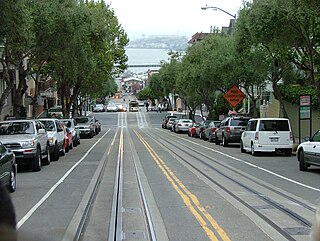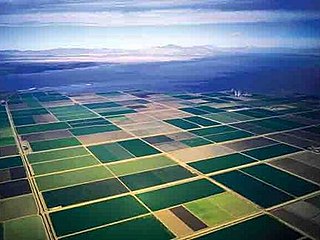Fraser River Provincial Park is a provincial park in British Columbia, Canada.
Hai Lake-Mount Herman Provincial Park is a provincial park in British Columbia, Canada. Protected by the park are regionally significant bog ecosystems and old-growth forests. The park caters to outdoor pursuits such as day hiking, camping, fishing, and hunting.

Point Conception is a headland along the Pacific coast of the U.S. state of California, located in southwestern Santa Barbara County. It is the point where the Santa Barbara Channel meets the Pacific Ocean, and as the corner between the mostly north-south trending portion of coast to the north and the east-west trending part of the coast near Santa Barbara, it makes a natural division between Southern and Central California, and is commonly used as such in regional weather forecasts. The Point Conception Lighthouse is at its tip.
The Xar Moron river is a river in Inner Mongolia, in northeast China. It flows through the grasslands of that region, forming a valley that is hospitable to both farming and herding. The valley was once home to the Khitan people.
Prado is a Spanish municipality in the province of Zamora, autonomous community of Castile and León. Its area is 10.95 km², and it had a population of 99 in 2004.

Katarzyna is a village in the administrative district of Gmina Piotrków Kujawski, within Radziejów County, Kuyavian-Pomeranian Voivodeship, in north-central Poland. It lies approximately 10 kilometres (6 mi) south-west of Piotrków Kujawski, 18 km (11 mi) south of Radziejów, and 63 km (39 mi) south of Toruń.

Ostrowik is a village in the administrative district of Gmina Radziłów, within Grajewo County, Podlaskie Voivodeship, in north-eastern Poland. It lies approximately 5 kilometres (3 mi) east of Radziłów, 26 km (16 mi) south of Grajewo, and 57 km (35 mi) north-west of the regional capital Białystok.
Cerro Bayo might refer to a number of mountains and Volcanos, specially in the Andean range between Argentina and Chile:

Januszewo is a village in the administrative district of Gmina Naruszewo, within Płońsk County, Masovian Voivodeship, in east-central Poland. It lies approximately 7 kilometres (4 mi) south-east of Naruszewo, 17 km (11 mi) south of Płońsk, and 50 km (31 mi) north-west of Warsaw.

Dębinki is a village in the administrative district of Gmina Zabrodzie, within Wyszków County, Masovian Voivodeship, in east-central Poland. It lies approximately 3 kilometres (2 mi) south of Zabrodzie, 13 km (8 mi) south of Wyszków, and 41 km (25 mi) north-east of Warsaw.

Karsewo is a village in the administrative district of Gmina Niechanowo, within Gniezno County, Greater Poland Voivodeship, in west-central Poland. It lies approximately 6 kilometres (4 mi) south of Niechanowo, 15 km (9 mi) south-east of Gniezno, and 54 km (34 mi) east of the regional capital Poznań.

Likusy is a village in the administrative district of Gmina Nidzica, within Nidzica County, Warmian-Masurian Voivodeship, in northern Poland. It lies approximately 15 kilometres (9 mi) north of Nidzica and 34 km (21 mi) south of the regional capital Olsztyn.

Lilac Park is an unincorporated community in Arnold, California in Calaveras County, California. Lilac Park Subdivision was approved by the CA Dept of Real Estate in February 1956. Arnold Lilac Park Homeowners Association (ALPHA) was incorporated on February 23, 1959. There are 205 home sites in ALPHA, not all are improved. The east side of Lilac Park sits atop Rocky Ridge and the west side follows SR 4. The community rests on a west facing slope.
Rancho Lompoc was a 42,085-acre (170.31 km2) Mexican land grant in present-day Santa Barbara County, California given in 1837 by Governor Juan B. Alvarado to Joaquín Carrillo and José Antonio Carrillo. The grant extended from present-day Lompoc west to the Pacific coast.
Rancho Mission Vieja de la Purisma was a 4,414-acre (17.86 km2) Mexican land grant in present-day northern Santa Barbara County, California given in 1845 by Governor Pío Pico to Joaquín Carrillo and José Antonio Carrillo. The grant included the original site of Mission La Purísima Concepción, located north of present-day Lompoc.
Rancho Ex-Mission la Purisima was a 14,736-acre (59.63 km2) Mexican land grant in present-day Santa Barbara County, California given in 1845 by Governor Pio Pico to Jonathan Temple. The rancho derives its name from the secularized Mission La Purísima, but was called ex-Mission because of a division made of the lands held in the name of the Mission— the church retaining the grounds immediately around, and all of the lands outside of this are called ex-Mission lands. The grant was north of the Santa Ynez River and present-day Lompoc and encompasses present-day Vandenberg Village. The grant was defined by the boundaries of the earlier surrounding grants, viz: Rancho Mission Vieja de la Purisma, Rancho Jesús María, Rancho Lompoc, Rancho Los Alamos, and Rancho Santa Rita.
Cuma is a village in the District of Mudurnu, Bolu Province, Turkey. As of 2010, it had a population of 89 people.

Hyde Street is an iconic street in San Francisco, California. Hyde Street connects the Aquatic Park Historic District to Market Street. The street is known to be one end of the Powell-Hyde terminal of the San Francisco Cable Car. The street also became famous for Rice-A-Roni commercials; almost every commercial ends with a cable car on the street.
Samovila is a village in Krumovgrad Municipality, Kardzhali Province, southern Bulgaria.








